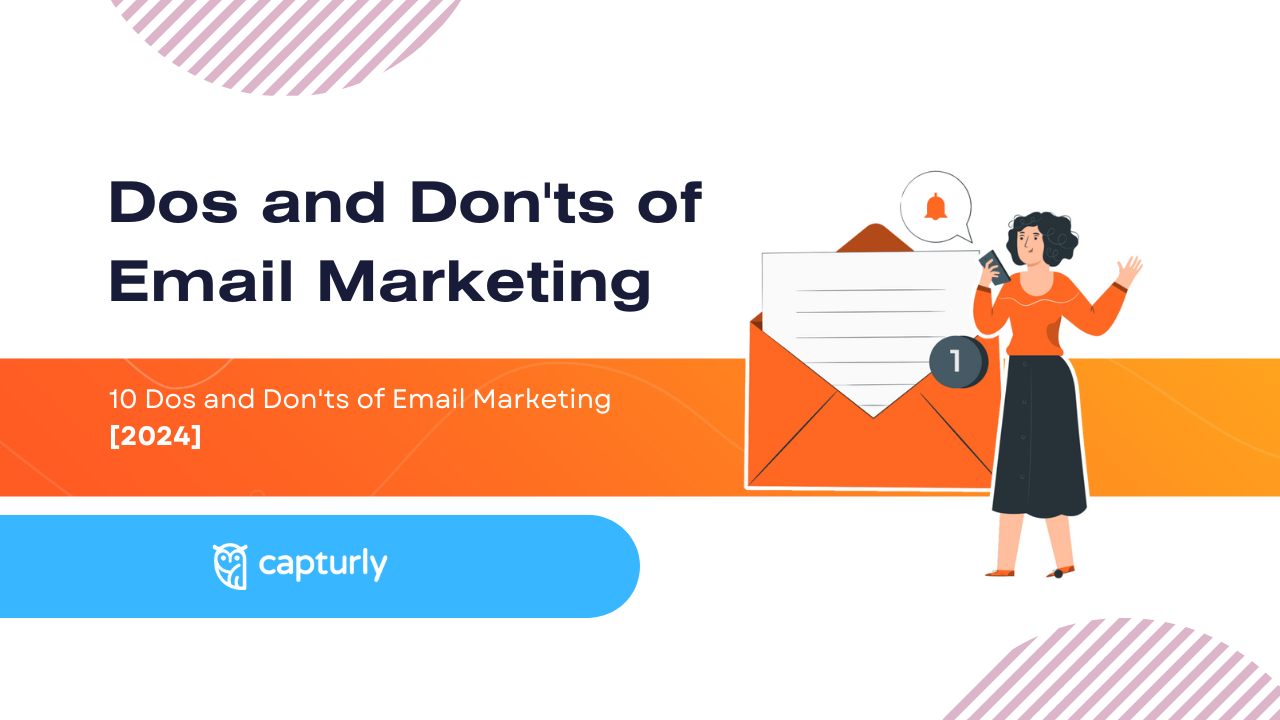Email marketing is not just sending the same old emails to your customers. On average, a normal person gets 23 emails a day, and overall we get 88.9 billion spam emails every day according to Statista. Do you think we have time to read all of the received emails? Not at all! We try to sort the most important ones out of all, which bring us some advantages or are just simply exciting to us at first sight.
It seems like an easy job, like all of us can create exciting stuff, and it shouldn’t cause any problems at all. Well, that’s a little more complicated. First, email marketing is a complete material, full of rules, and requirements you need to pass from time to time. Second, sometimes it’s harder to convince buyers with just a few words and a colored background.
Think back to your history essays. From the time you didn’t learn the material. You rather wrote a short essay instead of a long one. But after you completely learned it from word to word, you rather wanted to write a long essay. Why did you change your mind? Why did all of a sudden a short essay become much harder to write? Good question! The more you know, the harder it is to shorten your answer. This activity also appears in the marketing industry, especially in email marketing.
Luckily some people have already walked this road through. We have already experienced what is efficient to use in the world of email marketing, and what is not. In this article, we will share 5 do’s, and 5 don’ts, what you should, or shouldn’t do during the process of creating emails for marketing purposes.
Table of Contents
What is email marketing?
Now that we have already mentioned some parts of email marketing, we may message those who have never really heard this expression before. It’s not an issue, maybe you are new in the online scene, or just always skipped this part.
According to Coursera, email marketing is a form of digital marketing whose objective is to create brand awareness, stimulate customers for purchases, and inform customers about the latest updates, and news.
Many forms of email marketing exist, the most popular are:
- Welcome emails – to create a relationship between you and the potential buyer
- Email newsletters – to educate your customers, and notify them
- Lead nurturing emails – to convince your buyers differently, separate target groups need separate care
- Dedicated emails – to notify all of your target audiences about a new event, a new release, or something that everybody should know
- Survey emails – to collect quantitative data from your customers
- Milestone emails – to appreciate and think of your customers that they buy from your store, or are just generally interested in your brand from a specific period
- Birthday emails – thank your customers on their birthdays, and give personal gifts to them
- Re-engagement emails – if your customers visited your site in the past, but didn’t make conversions. Or if you sent an email to them, but they didn’t respond, or clicked through your site, but didn’t go through the shopping procedure. The main task here is to measure their problem and recommend solutions in this email
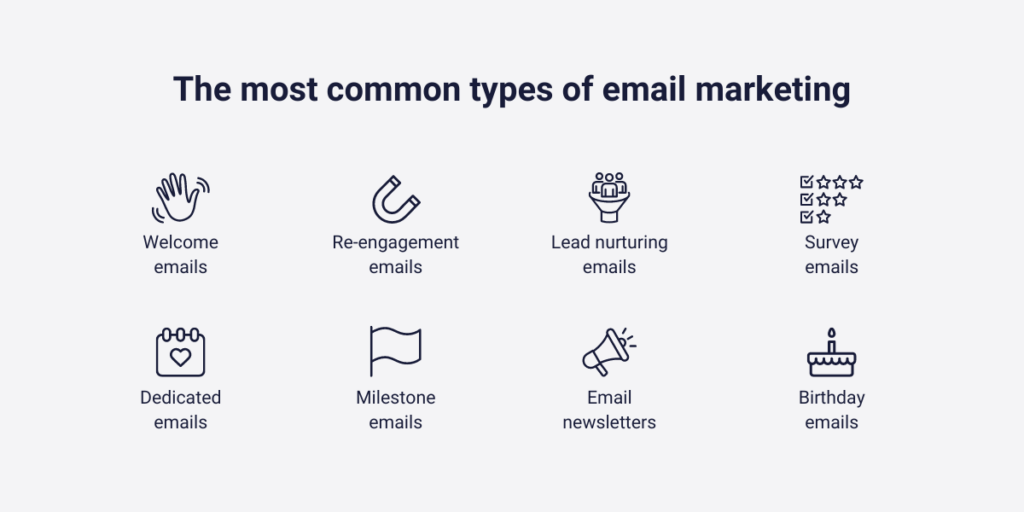
But, there are some others to look at! Each one has a different role, so be sure to use them accordingly. Now, we need to examine why email marketing is one of the most efficient ways of advertising.
Why is email marketing necessary to have?
Email marketing has definite advantages. In this chapter, we will speak about the most important strengths of email marketing.
Let’s see what can email marketing be efficient for:
Keep your customers informed
The customers are not using sites 9 to 5. If they detect an issue, and they decide to buy something to solve it, they will visit your site to buy the designated product. That’s how it usually works. Of course, it depends on the actual products that how frequently the problem occurs.
An example will illustrate this better: if you are selling perfumes you should expect more frequent orders from the same buyers, than if you sell fridges.
But in neither case do your users visit your site every day. That’s why you need to send them notifications about your actions, news, or updates about where your brand is going. Of course, you can do this on your social media accounts, but those are not that effective.
Allows you to target messages
According to McKinsey, 71% of consumers expect personalization, and 76% of them get frustrated if they don’t find it. In this decade customers want special care. And they know it rather depends on your willingness than your resources. Personalized messages not only work via emails. But that’s the most effective way of presenting targeted messages. With good preparation, you can sort your potential clients’ emails into groups. One group of them is currently stuck in the buying stage, but one of the groups is only in the consideration stage.
If you already had enough time to gather data, now you can easily tailor your messages to these maintained groups. If these messages are efficient you can even multiply your conversion rates, and decrease conversion funnel friction!
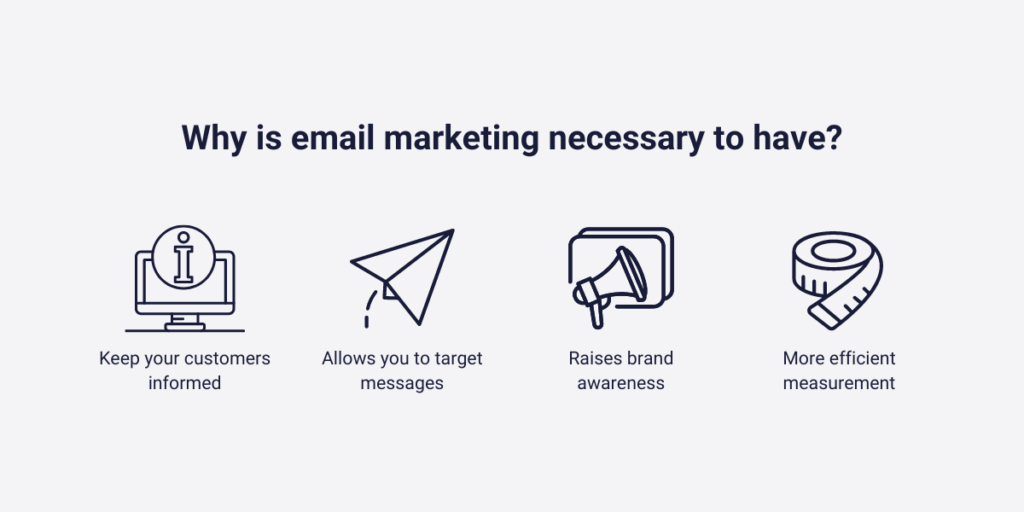
Raises brand awareness
What we always try to highlight in our articles is that most online industries have really big competition. Just think of it: here, most of the time you not only compete with your regional competitors, but companies can enter the market from all over the world. Since ships and airplanes can bring your products everywhere in just about a few days, competitors can serve those buyers’ needs also. Moreover, in terms of online products and services, the buyer gets the product or service immediately.
In this case, there’s no cost difference between a company from Brazil and a company from Australia that sells the same product and both want to serve the needs of the same people.
That’s why you need to get highlighted! But it is way easier to say than do. And even if you created a unique brand’s values, mission, and vision, how can you be sure that plenty of your potential buyers will actually read them through?
Email marketing can ensure that! According to Hubspot Research, email marketing conversion rates are between 2-3%. It may be less than you think, but believe me: it is a good ratio compared to other marketing options. And I can assure you: this is an average number, and if you constantly use our carefully sorted tips (in the next chapters) you can even climb higher.
More efficient measurement
And one thing, before moving forward. Measurement is so much easier in this marketing scene than in others.
I will introduce this through an example of our online data analytics company: Capturly Analytics!
Capturly Analytics recently introduced its email surveys feature, which makes your potential customers’ opinions, and behavior easily trackable. Capturly’s offer is, that after the customers make conversions on the site (buy something, subscribe to something, or just click on a CTA), the users automatically get surveys in their email boxes. This survey can be completely customizable, and because it’s not just a pop-up on the actual site, more users deliver them back.
Here, the users can rate their satisfaction on a 1 to 10 scale, where 1-6 mean dissatisfaction, 7 to 8 mean a neutral comment, and 9-10 mean they are satisfied with your service. Also, you can ask other questions in this scale system based on what they did on your site beforehand. After you evaluate the negative results, you can watch individual sessions to look closely at where their potential negative feelings originated from.
Don’t be afraid, if your customers don’t fill out these surveys. We already wrote an article about this topic. With email marketing, you can gain more information about your brand, and discover your webpage’s bugs, and areas of improvement.
How should we build up our email marketing strategy?
Email marketing is a very sensitive creation. One bad habit can lead to the loss of potential buyers. That’s why email marketing needs a very precise strategy. It contains a crystal clear mission: why do you want to send emails to your customers?
- to convince them to repurchase?
- to inform them about the updates?
- to educate them?
Because it all requires different approaches!
Then you need a well-built email. Engaging subject line (I encourage you to read this article to get more information), great graphical elements, and short but effective sentences. Strive for personalization, mobile-friendliness, and automation. Ensure that you send these emails at the right time, and call your segment in the right manner.
After the start of your email campaign, you need to track its success, and after the end date, you need to evaluate the results. Some forms of email marketing never stop. You need to track these successes month by month, and if you realize a decrease in their success, change some of your habits, and find the source of this fall.
As you can see by now, it’s a complex industry. That’s why we know, these little insights are not enough, you need more precise tips. That’s what motivated us to create this article for you.
5 dos of email marketing
In the next chapter, we will highlight five must-do things you need to apply to create successful marketing emails.
Make your subject line personalized
“Eric, I still want to connect” – That’s one of LinkedIn’s emails in my email box.
Why is it super effective? Because it speaks for me! LinkedIn indicates this way if you have pending connection requests on their site.
Let me show you another example of LinkedIn. “Eric, you’re only a conversation away from a great hire.” In this case, the app wants me to create a job to find the perfect candidates through their site.
What do you think, it would reach the same efficiency if they would miss writing the names down? I don’t think so. According to research made by DynamicYield in 2024, 60% of North Americans, and more than 80% of Asians and Europeans react favorably to content that contains personalized elements.
Another study: according to Experian, personalization can increase email open rates by more than 25%!
This is a big opportunity, and it’s not that hard to introduce either.
You only need the customer’s name connected to their email address and a big automation service that does this all by itself. These usually work with personalized tags, so you only need to create the tags and write information inside these tags about the most prominent characteristics of each potential buyer. When you make the emails, you only need to choose the tags, and the program inserts the written characteristics inside these tags.
Use down-selling methods
Imagine that you know that one of your visitors exited your site even before reaching the buying stage.
What is the reason for that behavior? Maybe, the visitor wasn’t happy with the price. Okay, that’s manageable. Re-engagement emails are really popular, but not those that want to convince your visitors more and more aggressively. In fact, if your customer doesn’t want to buy something, he doesn’t want to do that, even if you beg him. Your brand’s reputation just goes lower and lower in his eyes.
However, if you give them options, options that can replace the product that the visitor found super expensive, may generate some conversion.
A good example of that is a cloth-related E-commerce shop. Julia, the customer wanted to buy something, but after she added the product to the cart, she changed her mind. That’s a good opportunity to send an email like this.
“We have more options to discover in cat-pattern pajamas:” – and here you sort out 3 cheaper, but the same quality alternative products.
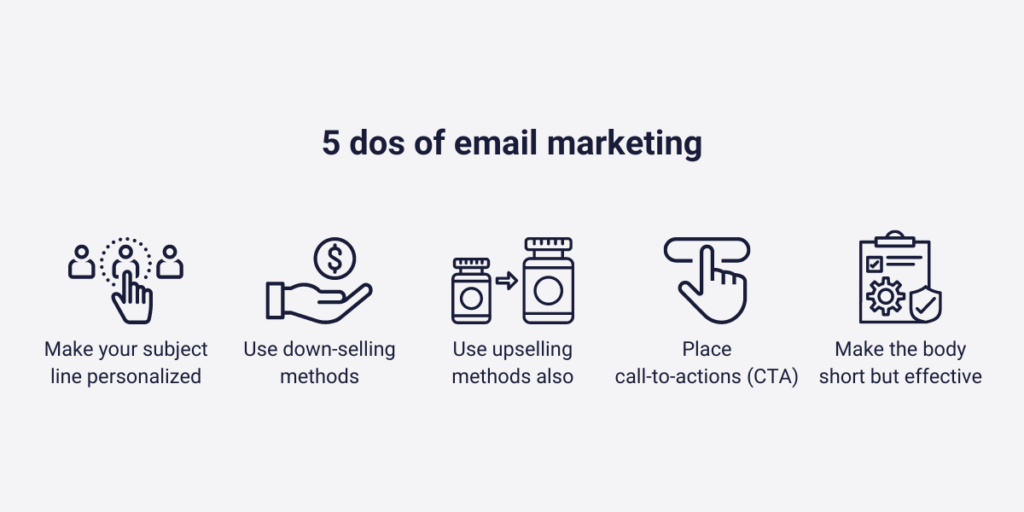
Use upselling methods also
Imagine that some of your customers are already using your product or service, but that’s not enough! You want to persuade them to subscribe to one of your better (but more expensive deals).
Well, that can work. At least Grammarly can ensure that. Grammarly sends “your XXXX year’s statistics” to their users every single year. In these emails, they highlight how many times you used their service, how many words Grammarly corrected, and how many words you wrote.
But the relevant thing comes now: they emphasize how many more corrections you would get if you used their paid plans. This is convincing! And even before you can actually think out this decision slowly, they don’t let you.
Because they place their call-to-action button!
Place call-to-actions
Call-to-actions are little buttons that can directly lead customers to the primary action you want them to take. Most of the time to the buying stage.
Call-to-actions rather appear after the user reads about the company’s value proposition, and the company is already convinced why this decision serves her needs.
There are plenty of long descriptions about how to use call-to-actions in email marketing at the maximum level, but this quantity of knowledge is worth writing an article about only this topic. However, we can highlight some important parts!
- Your language inside the call-to-action must fit with the language of your whole article
- Place it (them) in an easily recognizable place, and highlight it with unique colors
- In terms of size, it should be bigger than other written elements in your email, but don’t go from one extreme to the other
Make the body short but effective
In these times, nobody wants to spend their life with unmeaningful activities. And reading an hour-long email from one of the lesser-known brands seems like a bad time. Customers want crystal clear reasons why they need to buy products from you. Telling stories, and unrelated facts just don’t belong here.
What belongs here? First of all, a hook! “We know men are needed to notify sometimes” – this example comes from a cake manufacturer. What did I forget again? – asked myself when I read this hook. That’s what it needed to achieve. The reader needs to ask himself questions.
After, the main message comes! “It’s just a few days from Women’s Day!” – Oh yes, that’s what I forget!
And finally the supporting information: “Order now, and we can still deliver to you before Women’s Day!” – Here is what everything makes crystal clear. That’s the plan you need to follow in order to reach better conversion rates through your email marketing!
5 don’ts of email marketing
But there are several things you need to consider again. In this part, we will look at common mistakes, mistakes that you should NEVER make in your email marketing campaign!
Don’t sell and buy data
One of the most important ones, and the most hated ones altogether. We need to distinguish two different things.
- Gathering data is crucial. If you neglect it you can’t write tailored messages to your customers. But gathering means you are the one and only element in this equation.
- Selling data is unethical, and some forms are illegal.
You may think that buying data, (for example email addresses) is a little bit better idea. Well, if selling data is the worst possible thing, then buying these data also brings negative effects.
First of all, according to some countries’ laws, both selling and buying are banned, and punishable.
Second; how do you know that the list contains data of people who you want to target? It’s similar to gambling. In the long run, you always lose!
Don’t use too many emojis
After emojis appeared, less experienced marketers started to use emojis like a dot at the end of the sentences. Don’t get me wrong, emojis are relevant to have. Nethunt’s research found out that people are 56% more likely to open emails with emojis in the subject line.
Emojis can highlight your email amongst the others, emojis are inclusive in all languages, and help indicate ironic jokes. But, they can be annoying. Don’t end all of your sentences with three separate emojis, as it rather makes them worse than better.
“One emoji can grab attention and feel a little playful, but go beyond that and you run the risk of looking unprofessional.” – Do you know who said that? Drs Davide Orazi, the Professor of Monash University Business School. This conclusion was based on a study of 195 thousands of Airbnb listings.
Don’t overdose your clients with emails
Email marketing is a great way to convince your buyers to go back to your site, but it does not affect everybody. Some people even want to avoid getting any promotional messages to their email addresses.
Even if the potential buyer sees your email, and you do everything right, there’s a high chance that he will ignore it without clicking on the actual email. That’s a problem? No, the next month you try to create another email with changed titles, maybe he will react to that slightly more intensively. Email marketing is a little subjective world, we all have different favorites, based on colors, hooks, or graphical elements.
Accept this! And don’t resend it quite frequently. Based on the studies, you need to wait at least 3 days to send a follow-up. Then 3-5 days to send it again.
And, that’s it. There’s no need to resend it more times, based on my experience. There’s a significant chance that you won’t get an answer if your third email remains unopened. Moreover, it may have negative consequences, like unsubscribing from your promotions!
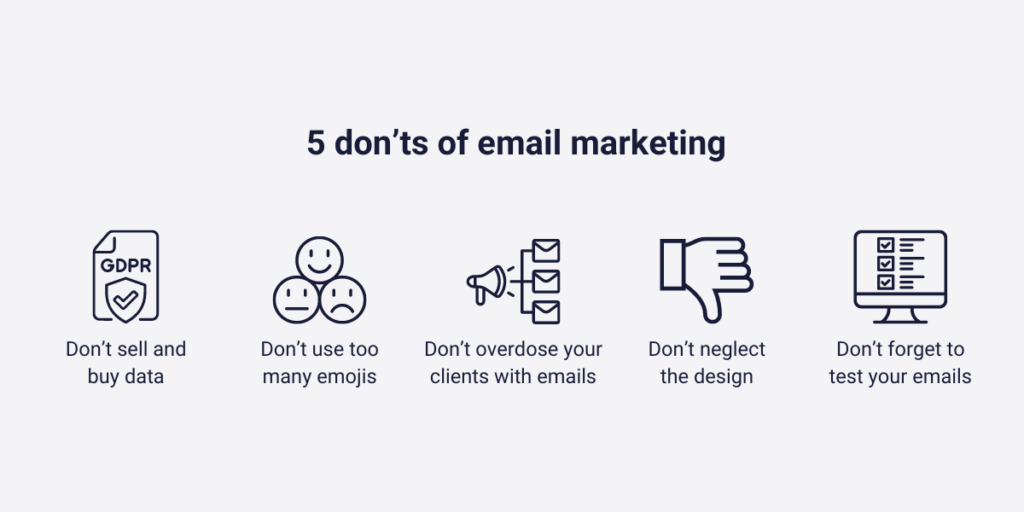
Don’t neglect the design
Of course, not the design is the most important thing in email marketing. You can reach reasonably good numbers without paying money to designers.
No, I’m not saying a plain white background is enough to generate conversions. But templates can save your email marketing success! There are many template generators across the internet, and many of them have free versions. That’s a good first step. Although, if you are big, that’s not enough.
Your design needs to highlight the colors of your company, and all of the elements must fit with your image. Like in this picture, of Burger King’s email:
Don’t forget to test
Last but not least, we shouldn’t forget the one, we always want to skip.
“I am working on this email for 8 consecutive hours, I won’t spend my next two on this” – these kinds of speeches lead to the worst possible scenarios, I can assure you of that.
There are many parts of emails that require testing:
- Readability and grammar – for obvious reasons
- Pictures – whether you put them in the right place, and whether they load fast
- Links – CTA-s direct the readers where you want
- Responsiveness – Do all devices react the same way to your email?
- Are you sending to the target audience that you wish to reach?
If you check everything twice, and there are no more obstacles in front of you, you can finally send your emails to your audience!
Conclusion
In this article, we introduced to you the basics of email marketing and more. More, because if you take our advice, and implement your marketing strategy based on our writings, you are prepared for many things.
Email marketing still has its relevance, and even if this industry becomes more automated than ever, its power doesn’t vanish. It’s your choice to fully take advantage of that power, and earn more conversions, decrease conversion funnel friction, and get more profit, with the help of email marketing!
Don't forget, sharing is caring! :)

